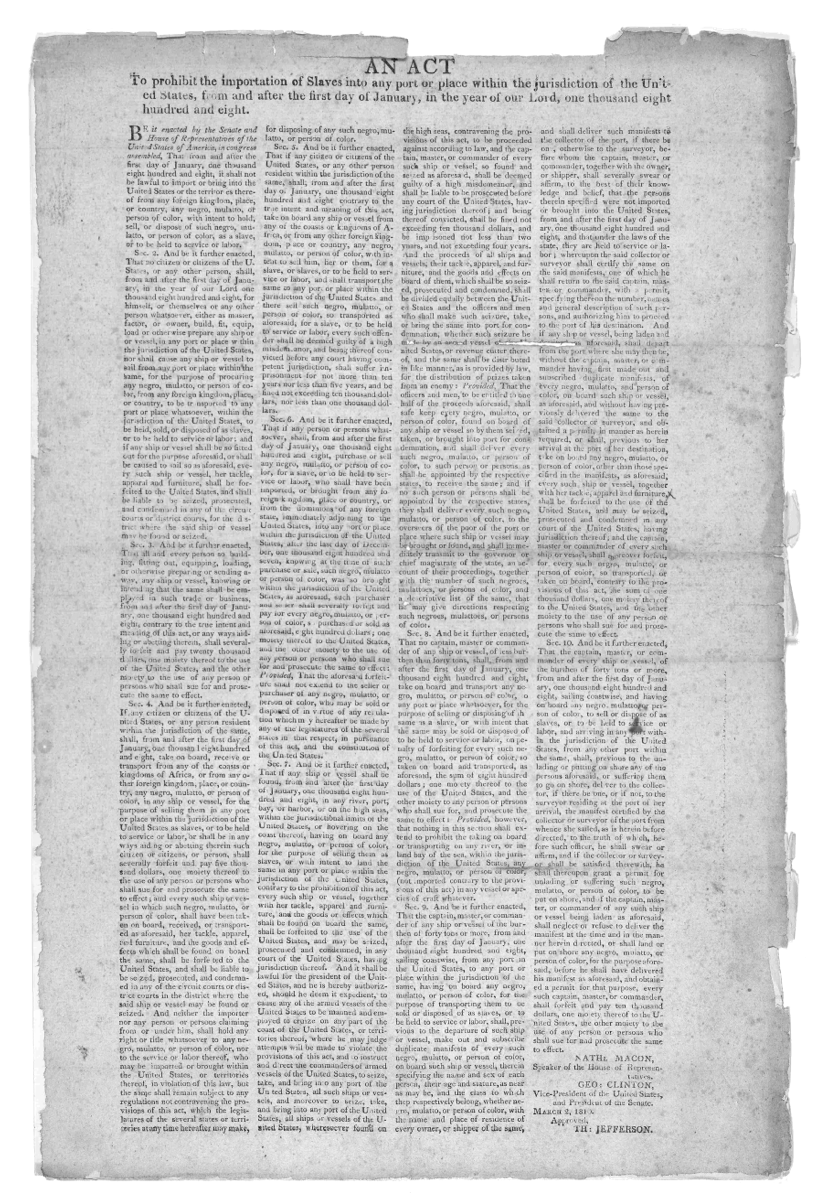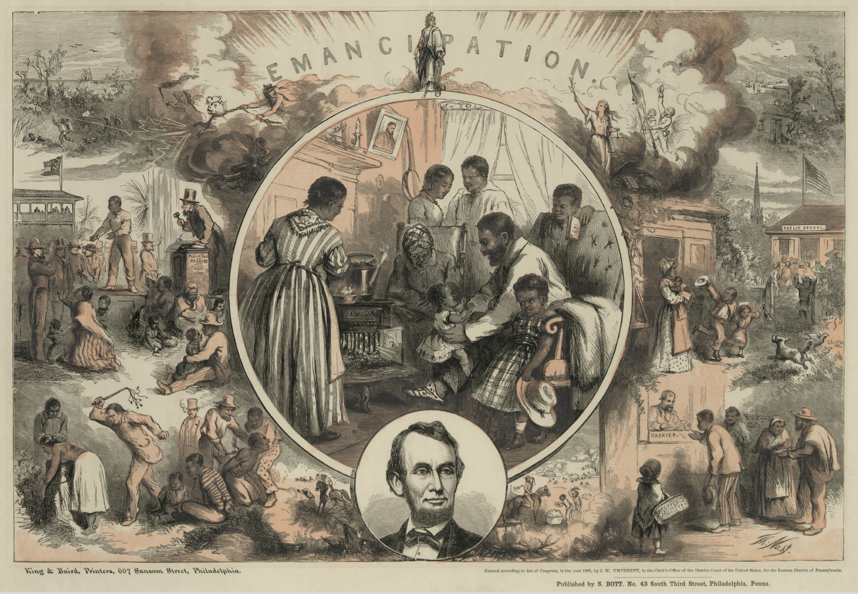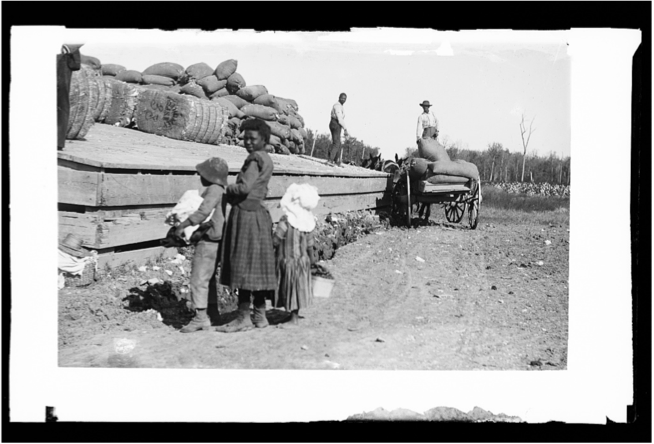1808
Slow March to Freedom

Importation of enslaved outlawed
By this time, the economies of Northern states were much less dependent on enslaved labor. The enslaved population in the South, over four million people, was considered self-sustaining — the domestic slave trade remained legal, and children of enslaved people were also automatically considered enslaved. As such, some Southern congressman joined with the North in voting to abolish the African slave trade.
1810
Race and Insurance
Emergence of Black-owned insurance companies
The establishment of an insurance company by African Americans was a natural progression from beneficial organizations like the Free African Society, which had emerged just after the American Revolution. Unfortunately, the African Insurance Company closed its doors in 1813. While the company was short-lived, the early model it provided would eventually be adopted by many successful post-Civil War era Black-owned insurance companies, including North Carolina Mutual Life (1989), Atlanta Life Insurance Company (1905), The Booker T. Washington Insurance Company (1923) and Golden State Mutual Life Insurance Company (1925).
1840s
Race and Insurance

Slave insurance is a booming business
After the importation of enslaved people was outlawed, many slave owners rented out enslaved people to skilled industries such as blacksmithing, carpentry, construction, coal mining and steamboat operations for additional income.
There were many occupational hazards that accompanied these skilled jobs, and slave owners sought to insure their property, taking out policies on the enslaved to ensure compensation in case of peril.
“Slave insurance was one of the earliest forms of industrial risk management, providing an important source of revenue for some of today’s largest multinational insurance companies.”
– Michael Ralph, William Rankin
1863 - 1865
Slow March to Freedom

Emancipation Proclamation heralds freedom for the enslaved
This document did nothing to free the millions of enslaved people in border states that were loyal to the Union, but it opened the door to the permanent abolition of slavery in the US. Lincoln worked with Congress to pass the 13th Amendment in January 1865, which abolished slavery across the United States.
News of the Emancipation Proclamation took two and a half years to reach the Western edge of the Confederacy. The proclamation was read by Union soldiers in Galveston Texas on June 19th, 1865 – an event that is now commemorated as “Juneteenth,” and was ultimately declared a Federal holiday in 2021.
1865
Pushed to the Margins
FREEDMEN’S BUREAU Established
The Bureau was in effect for only one year post-war. Citing preferential treatment and huge federal financial burden, Andrew Johnson vetoed an extension twice. Johnson continued to undermine the Bureau and Congress succumbed to pressure to dismantle the Bureau in 1872.
1865
Segregation Codified
KKK is born as Southern states pass “Black Codes”
South Carolina limited Black people to jobs like farmer or servant by imposing taxes on them for serving in other roles. In some southern states, any employer who offered higher wages to a previously contracted Black laborer could be punished by law. These Black codes were enforced by all-White police and all-White judges (many former Confederate soldiers) and were the original “Jim Crow” laws.
1875
Fight for Civil Rights

Passage of Landmark Civil Rights Act and Rise of Equal Opportunity “industrial” insurance policies
Included as part of an amendment to a general amnesty bill for former Confederates, the 1875 Civil Rights Act guaranteed all citizens, regardless of color, access to accommodations, theaters, public schools, churches, and cemeteries. The bill further forbids the barring of any person from jury service on account of race, and provided that all lawsuits brought under the new law would be tried in federal, not state, courts.
In 1883, the Supreme Court ruled this act unconstitutional, nullifying it’s efforts until the return of the Civil Rights movement in the 1960’s.
One large insurance company pioneered what was known as the “industrial” life insurance policy – a coverage that cost only a few cents and paid for burial costs for the deceased. The low cost made these policies accessible to all people, regardless of race or economic standing, and the company was able to turn a profit on huge volume of policies sold.
1880s
Race and Insurance

Race-based insurance pricing formalized
Most major life insurance companies followed suit. Across the industry, companies blocked or disincentivized agents from soliciting Black customers, including not paying commissions for policies sold to Blacks.
This practice was defended years later, after the passage of anti-discriminatory insurance laws, by “statistically proving” higher mortality rates for Blacks.
“The myth of the actuary is the idea that there is a reality in the world that can be captured by rational choice models and statistical analysis—and that insurance companies do this ethically, objectively, and ‘correctly.’”
– Brian Glenn, political scientist (2003)
1890s
Pushed to the Margins

Poll Taxes and “grandfather clauses” limit voting for Blacks Across the South
In 1890, Mississippi law required voters to pay the poll tax before they could cast a ballot in elections. Between 1890 and 1908, South Carolina (1895), Louisiana (1898), North Carolina (1902), Alabama (1901), Virginia (1902), and Georgia (1908) adopted similar laws to exclude Blacks and make it harder for poor Whites to vote.
Literacy tests to determine voter eligibility were applied at the discretion of White registrars who used this power mainly against Blacks.
Many of these laws could have similarly disenfranchised poor White voters, if not for the “grandfather clause,” which exempted from eligibility tests those who were able to vote prior to the Civil War, or who had a father or grandfather who was previously able to vote.
1896
Segregation Codified
Statistician publishes “Race Traits and Tendencies of the American Negro”
“…most of the conclusions drawn from these facts are of doubtful value, on account of the character of the material, the extent of the field, and the unscientific use of the statistical method.”
– W.E.B Du Bois on Hoffman’s work
